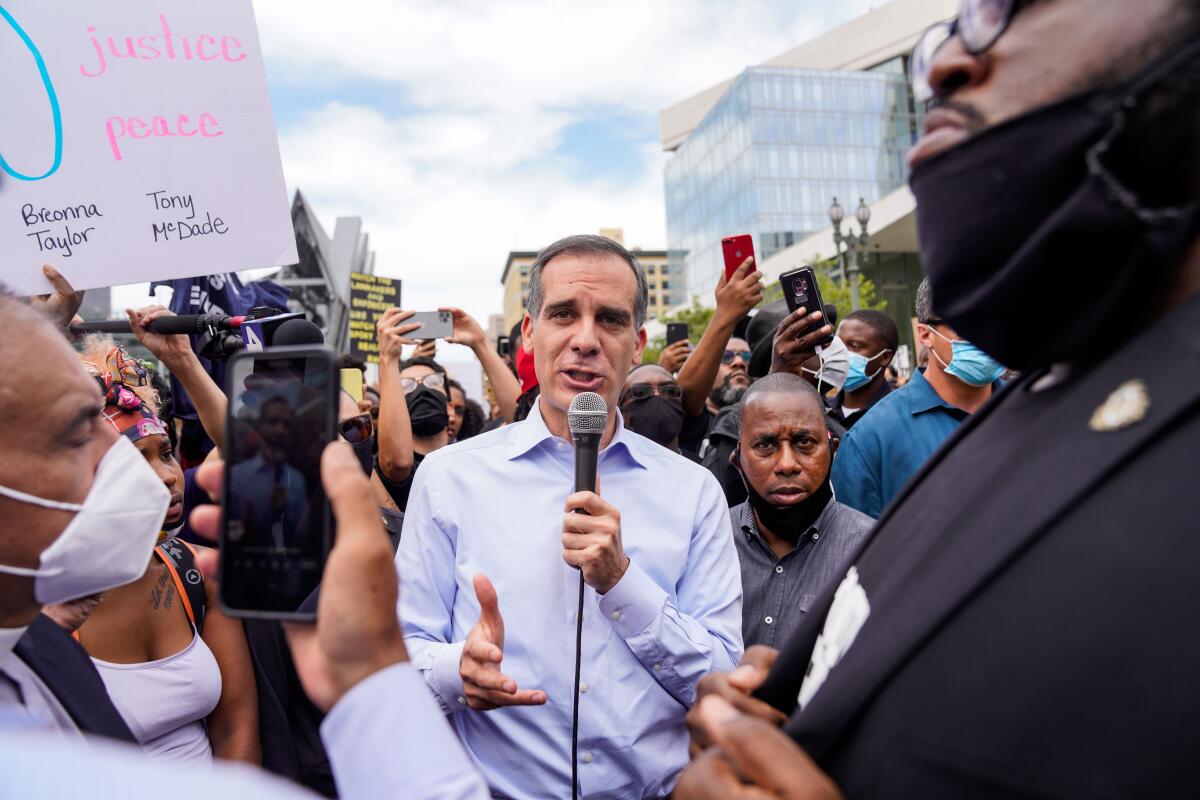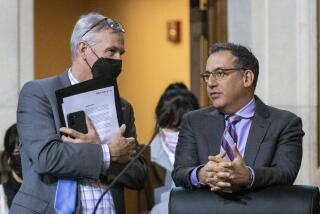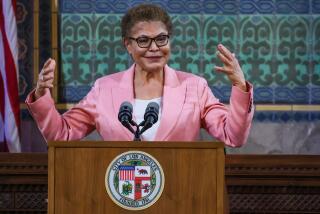L.A. aggressively expanded the police force for 3 decades. Now, a political shift means cuts
Even before the Los Angeles riots in 1992, many at City Hall believed that the Los Angeles Police Department was too small to effectively patrol such a sprawling city. They noted that L.A. had fewer cops per capita than some other cities and that L.A.âs huge geography caused its own unique challenges.
So, for more than two decades, L.A. pushed to expand the department. The magic number was 10,000 officers. And in 2013, L.A. hit that number.
But by then, there were voices at City Hall questioning whether more expansion was needed and whether it might be time to trim the LAPDâs budget to preserve other city programs during tough economic times. Some also noted the huge drop in crime during that period, a dramatic difference from the late 1980s and early 1990s.
The LAPD budget, however, remained largely protected â even as Black Lives Matter and other groups pushed to cut funding.
On Wednesday, after days of massive protests over the death of George Floyd, Mayor Eric Garcetti said he supported budget cuts for the LAPD. That statement marks a major shift for Los Angeles, though many of the details still are being worked out.
What is Garcetti proposing?
Garcetti had originally proposed a 7% spending increase for the LAPD, including a lucrative package of raises and bonuses for rank-and-file officers.
But Wednesday, a day after thousands of protesters chanted âDefund the policeâ outside his Windsor Square home, Garcetti said he had changed course, deciding now is not the time to increase the department budget.
Garcetti said his administration would look for $250 million in cuts from city departments, including the LAPD, and steer the funds to investing in jobs programs, health initiatives and other services supporting the black community and other communities of color. As part of those reductions, the LAPD would see cuts of $100 million to $150 million, he said.

Council President Nury Martinez and several of her colleagues proposed the same reductions for the LAPD, which would eliminate the increase planned in Garcettiâs budget.
âWhile a complete overhaul of the cityâs budget will take time, we can begin to slowly dismantle those systems that are designed to harm people of color,â Martinez said. âA preliminary cut to the LAPD budget will not solve everything, but itâs a step in the right direction.â
How much of L.A.âs budget is taken up by police?
Garcettiâs budget, first proposed in April, called for police spending to consume 53.8% of the cityâs âunrestrictedâ general fund revenue â taxes that are not earmarked for special purposes or certain fees, fines and grants. The LAPD makes up 17.6% of the cityâs overall $10.5-billion budget, a figure that does not include police pensions and healthcare, according to city budget officials.
The amount of police spending in L.A. has long been a source of frustration for activists. This year, Black Lives Matter-Los Angeles teamed up with other grassroots organizations to survey Angelenos about their budget priorities and draft their Peopleâs Budget.
Under their alternative spending plan for the coming year, police would receive only 5.7% of the cityâs general fund.
How have activists, others reacted?
Progressive activists say Garcettiâs actions do not go far enough. Meanwhile, leaders of the LAPDâs biggest union were furious with Martinez over her statement that government systems were âdesigned to harm people of color.â They said her choices of words was âoffensiveâ and dehumanized police officers.
Council members have shown little appetite for cutting the LAPD as dramatically as outlined in the Peopleâs Budget. But several said in recent days that they could not shield police officers from cuts when other employees were facing reductions.
Why is this moment so big?
The LAPD struggled for decades with a series of scandals as well as widespread evidence of bias and abuse toward minorities during the era of chiefs including William Parker and Daryl Gates. Gates infamously said blacks fared poorly under police chokeholds because their physiology was different from that of ânormalâ people.
The videotaped beating of black motorist Rodney King and the riots that followed the acquittal of white officers sparked the beginning of reforms that continued after another scandal involving officers at the Rampart division.
The LAPD is now more racially diverse than ever. And although the reforms have generated praise even from longtime critics, problems persist. The department has struggled with the number of black officers.
Leaders long argued that a larger number of officers would mean better, less militaristic policing of the city.
But that argument has been challenged, not just by activists and advocates of criminal justice reform but also by those who say, with crime so much lower than in the past, it makes more sense for the city to invest in other things.
Back in 1990, the 10,000 plan was designed to boost the LAPD staffing by 25%. At the time, the LAPD had more than 8,000 officers, which represented at 2,000-person increases from several years earlier. Some thought it could be done in a few years. It took almost two decades.
One of the architects of the plan to expand to 10,000 officers was quick to note there was no science to that goal.
The 10,000 figure lacked any analytical underpinning but was âa nice round number,â then-Supervisor Zev Yaroslavsky said at the time. It also âtakes the force from four digits to five digits.â
More to Read
Sign up for Essential California
The most important California stories and recommendations in your inbox every morning.
You may occasionally receive promotional content from the Los Angeles Times.














